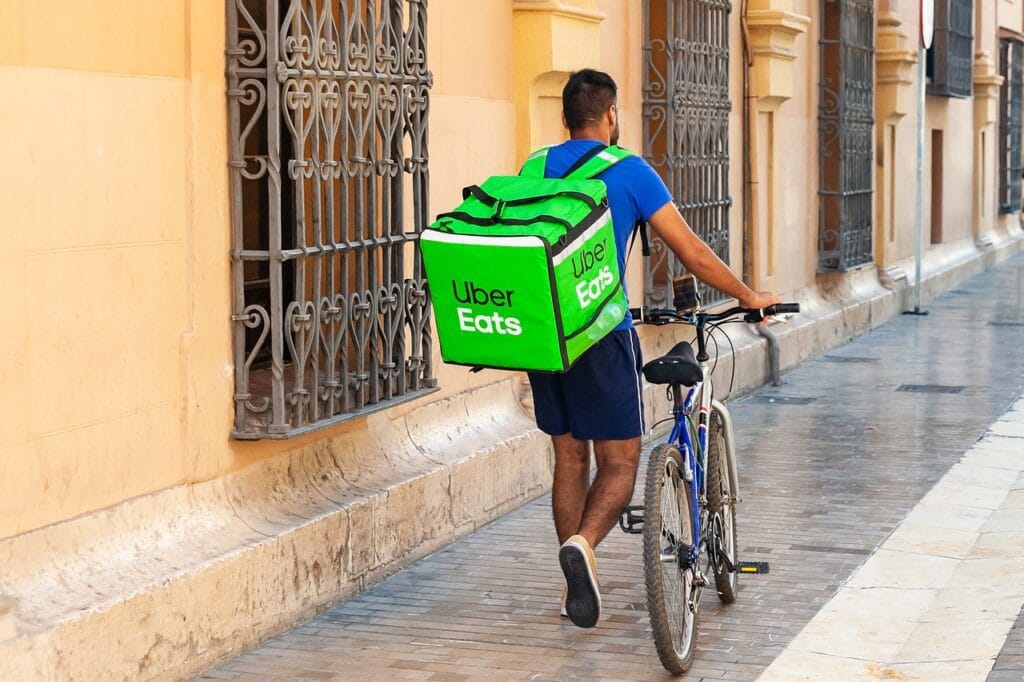
Organic Traffic Analysis
The online food takeaway market is booming with the increase of consumers who crave convenience and variety at their fingertips. These platforms offer a convenient way for customers to browse a wide range of restaurants and cuisines, placing orders with just a few clicks. As a result, they have transformed traditional dining habits and increased the availability of diverse food options, making it easier for people to enjoy meals at home or on the go. This growth reflects a shift towards online convenience, driven by changing consumer preferences and advancements in technology. For takeaway outlets, appearing prominently in search results can mean the difference between a satisfied customer and a missed opportunity. As we explore the marketing strategies of leading online food takeaway platforms, we’ll uncover how they position themselves to attract hungry consumers and thrive in this competitive marketplace.

The above data presents the organic traffic for four popular food delivery platforms—Domino’s, Uber Eats, Just Eat, and Deliveroo—over a 12-month period from August 2023 to August 2024.
Just Eat consistently leads in organic traffic, with numbers significantly higher than its competitors, peaking at 11,691,895 in May 2024. This correlates with the number of keywords it was ranking for in May which was much higher than other months.
Uber Eats and Deliveroo have similar traffic trends, with Uber Eats occasionally surpassing Deliveroo, but both remain significantly below Just Eat and Domino’s.
There are noticeable fluctuations in traffic across the months, likely influenced by seasonal trends and marketing campaigns. For example, Just Eat’s traffic spikes in May and June 2024, possibly due to promotional offers or increased consumer demand during the summer months.
Across all platforms, January 2024 shows a dip in traffic, which might be attributed to post-holiday behaviour, where consumers typically reduce takeaway orders.
Just Eat’s higher traffic could be linked to extensive partnerships with various restaurants, leading to a broader customer base. Just Eat has rather cleverly targeted the broad terms of ‘near me’ keywords. The website ensures that restaurants are listed by location, and content is tailored to include local keywords such as “takeaway near me” or “pizza delivery in [city].” This localisation strategy allows them to capture search traffic from users looking for delivery options in their area

For platforms like Uber Eats and Deliveroo to increase their organic traffic, they may need to enhance their marketing strategies, expand their restaurant partnerships, and improve their visibility in search results with a stronger seo strategy. They currently rank for the same broader search terms that just eat are targeting but slightly lower down.

Meta Data Analysis
In my analysis of search results for takeaways in Manchester, I found that Just Eat ranks first, followed by Deliveroo in third place and Uber Eats in fifth. A key observation from the URLs is that Just Eat is the only one that includes the keyword “takeaways“ in its URL, giving it a competitive edge in relevance.
Meta Descriptions
Just Eat's Meta Description

The meta description is clear and concise, featuring an engaging call to action: “Order delicious food.”
It emphasises a crucial value proposition by highlighting convenience with the phrase “delivery direct to your front door.”
Importantly, it incorporates relevant keywords related to takeaways in Manchester, aligning perfectly with user search intent.
UberEats Meta Description:

In contrast, the Uber Eats meta description heavily lists specific restaurants, which leads to it being cut off by Google due to its excessive length. This makes the text appear cluttered and fails to provide a compelling reason for users to click, especially when compared to Just Eat’s concise, benefits-oriented description.
Header Tags
The H1 tag on the Just Eat URL is clear, direct, and closely aligned with search intent, signalling to both users and search engines that the page is relevant for queries about takeaways in Manchester.
Both Deliveroo and Uber Eats use multiple H1 tags on their pages, with Deliveroo featuring as many as six H1 tags. This can confuse Google, making it harder for the search engine to identify the page’s primary focus, which can ultimately dilute relevance and hurt rankings. Additionally, both brands overuse the terms “takeaway” and “Manchester” across their H1 tags, which could be perceived as keyword stuffing—a tactic that Google may penalise if it suspects manipulation of search rankings.
Furthermore, Uber Eats’ heading structure is not optimised, as an H2 tag appears before the H1 tag, which is not SEO-friendly and can mislead Google.
To improve search rankings for these competitive keywords, Uber Eats and Deliveroo could benefit from more engaging meta descriptions with strong calls to action, as well as optimised page structures to enhance relevance and clarity.
Meta Titles
In terms of meta titles, both Deliveroo and Uber Eats include the term “near me,” which is redundant since “Manchester“ is already specified. This redundancy can dilute their focus on the keywords they want to rank for. Additionally, both titles exceed the recommended length, leading to truncation and reduced visibility in search results.
The Just Eat meta title is straightforward and effectively targets the query with well-placed keywords. It is concise, avoids unnecessary repetition, and is less likely to be truncated, making it the most optimised option among the three.

Just Eat ranks for the most keyword which correlates with the amount of organic traffic it gets. Delivery services often partner with a wide range of restaurants, including local favourites and diverse cuisines. For instance, Just Eat claims to track over 73,000 restaurants in the UK alone, providing extensive options for consumers. This extensive network allows them to target a diverse array of local and national keywords related to various dining options, enhancing their search visibility. In contrast, Domino’s primarily focuses on its own branded pizza offerings and doesn’t utilise a wide network of independent restaurants, which limits the range of relevant keywords they can rank for.
Blog Content
One of the four pillars of SEO is content, yet none of these major food delivery platforms feature an active blog section. In fact, the only blog we found was on Just Eat, which hasn’t been updated in over four years. These companies rely primarily on their mobile apps and strong brand recognition, drawing users directly to their services without depending on organic search traffic. Their apps and sites are highly optimised for user experience, and with large, engaged customer bases, they don’t need to rely on SEO-driven content.
Moreover, with significant marketing budgets, they invest heavily in paid acquisition, consistently staying at the top of search results through paid ads rather than organic content. Their websites are designed as transactional platforms, focused on restaurant listings, menus, and locations rather than long-form content like blogs. With thousands of restaurant pages already driving organic traffic, they don’t need additional content to boost their visibility.
Ultimately, these platforms cater to a transactional audience—consumers looking to order food, not read articles. Their business models prioritise functionality and convenience, making content-driven SEO less critical for their success.
User Experience
These platforms deliver outstanding user experiences through intuitive design, seamless navigation, and personalised recommendations. Their apps and websites boast clean, minimalist interfaces that make browsing menus and placing orders effortless, with tailored suggestions based on users’ preferences and location. The ordering process is highly efficient, offering one-click reordering, multiple payment methods, and live order tracking, which provides real-time updates and full transparency from preparation to delivery. With mobile optimisation for fast loading and GPS integration for precise delivery times, users enjoy a smooth, on-the-go experience. Clear visuals, customer reviews, and responsive customer support, combined with easy feedback systems and accessibility options, ensure these platforms are not only user-friendly but also highly convenient for all customers.

As illustrated in the graph above, Just Eat enjoys a fairly even distribution of branded and non-branded traffic. Non-branded traffic comes from users searching for specific types of takeaways without a preference for any brand, leading them to Just Eat for a wide selection of choices. On the other hand, branded traffic stems from users who specifically search for ‘Just Eat’ to access the platform directly, knowing it offers multiple takeaway options in one place. The combination of strong search visibility for generic terms and brand recognition ensures that Just Eat captures both types of user intent In contrast, Domino’s Pizza significantly surpasses non-branded traffic on its site. This trend is understandable, given that many of their top organic keywords are directly associated with the brand. Domino’s has cultivated a recognizable brand through decades of marketing, making it synonymous with pizza delivery. Their commitment to innovation and customer engagement has helped them maintain a strong position in consumers’ minds

Domain Authority, backlinks and referring domains

Uber Eats stands out with the highest domain authority (DA) of 89, largely due to its extensive number of high-quality referring domains. While Just Eat has a greater overall number of backlinks, the quality of these backlinks is comparatively lower. Just Eat has 65,000 backlinks from domains with a DA of 81-100, whereas Uber Eats boasts 197,000 backlinks from domains in the same high DA range. This significant difference in the volume of top-tier backlinks contributes to Uber Eats’ stronger domain authority. The platform benefits from backlinks originating from some of the most reputable websites, including Apple, Google, and Yahoo. This strong backlink profile not only boosts Just Eat’s credibility but also enhances its visibility in search engine rankings.

Lost Backlinks
In June 2024, many websites experienced significant losses in backlinks due to Google’s Core Update, which focused on enhancing the quality and relevance of search results. This update further refined Google’s algorithms to assess the quality of backlinks, leading to the devaluation of low-quality, spammy, or irrelevant links. Websites that had relied on manipulative SEO tactics, such as purchasing links or participating in link farms, were hit hardest, resulting in a substantial drop in their backlink profiles. Conversely, sites with natural, high-quality backlinks fared better, as the update emphasised the importance of user experience and helpful content




Contact Us
Cheshire (Head Office)
Manchester
Get in touch
Let’s find the best solution for your business
